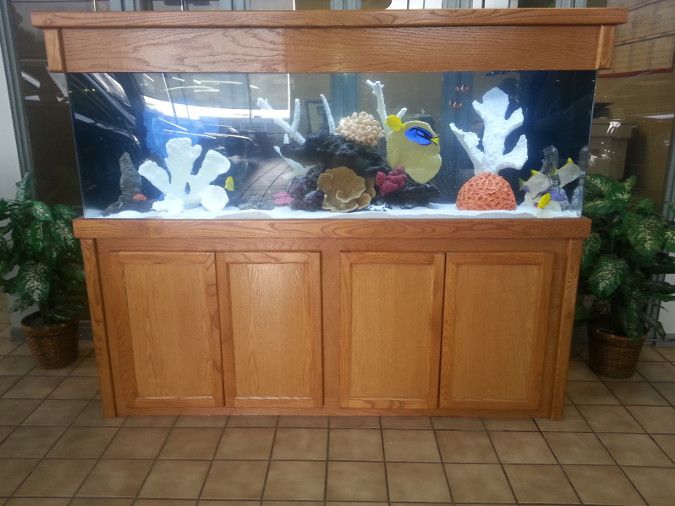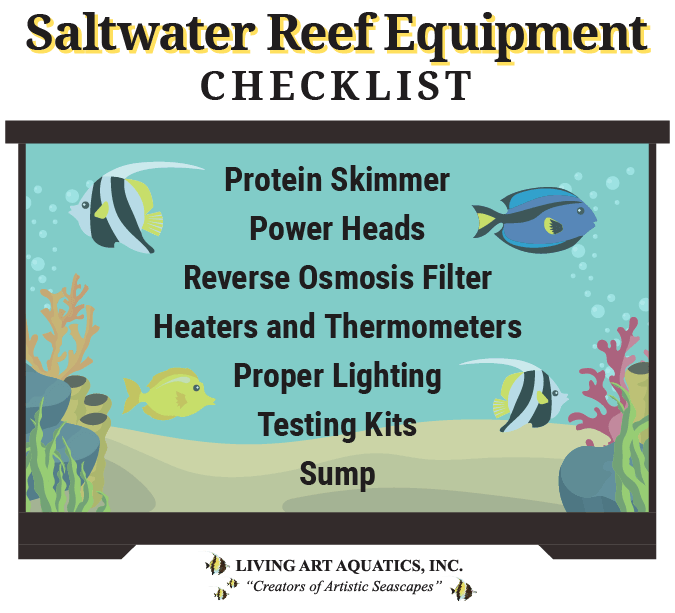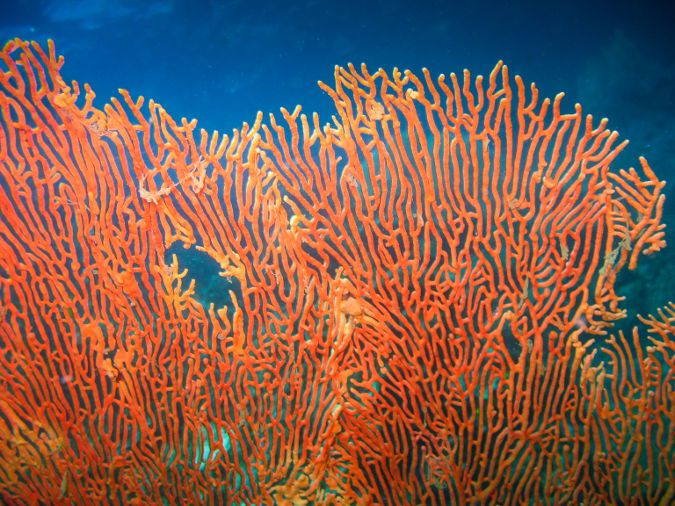Follow These Steps for a Vibrant Saltwater Reef Aquarium!
There’s no doubt saltwater aquarium is a stunning piece of living artwork. However, a coral reef makes it even better! After all, it never hurts to add the beauty of one of nature’s most intricate and diverse biomes.
Still, a reef aquarium requires a lot of care, which is a tall task for beginners. But if you’ve got some experience, the process is as rewarding as the result!
Here’s a rundown of how to get your reef tank started and keep it beautiful for the long haul.

It takes work to keep a saltwater reef aquarium looking this beautiful.
Step 1: Choose the Right Tank to Support Your Saltwater Reef
The first important choice you will make when starting your reef tank is whether you want an acrylic or glass aquarium. Both types of tanks will support a saltwater reef just fine. So, the choice ultimately comes down to personal preference.
Here are some factors you should be aware of when making your decision:
- Acrylic tanks are stronger, lighter, and more resilient to fluctuations in room temperature than saltwater tanks.
- Saltwater aquariums are more scratch-resistant and provide a clearer view of the fish than their acrylic counterparts.
You should also keep the size of the tank in mind when planning your aquarium. After all, saltwater weighs nine pounds per gallon. So, a 55-pound tank will weigh an extra 500 pounds when full! And we haven’t even included the extra substrate, live rock, and equipment in that estimate. So, make sure you pick a location that can support the size and weight of the aquarium you choose.
Step 2: Acquire All the Necessary Equipment
The next thing you will need to do is acquire a few essential pieces of equipment.
If you have experience maintaining a freshwater aquarium, then much of this equipment will be familiar. However, as you will see from the list below, there are several key differences to keep in mind.
Here is a list of the most important types of equipment for your saltwater reef aquarium:
Protein Skimmers
A protein skimmer is essential in every saltwater tank. Not only does it remove excess nutrients and waste from the water, but it also keeps oxygen levels high. Both functions serve to create a healthy environment for your livestock.
Powerheads
Powerheads will keep the water in your saltwater tank turbulent and flowing. Maintaining a consistent flow of water helps to reduce waste at the bottom of the tank or behind rocks. It also assists in breaking down material so that the protein skimmer can easily remove it.
Reverse Osmosis Water Filters
Using a reverse osmosis filter to treat your water will help you avoid many issues with water quality. You should filter your water before you first fill your tank and during each monthly water change.
Heaters and Thermometers
The ideal temperature for maintaining a healthy saltwater reef aquarium is 77°F. Therefore, you will need a dependable heater that can keep the tank at that temperature. You should also keep a thermometer in the tank so that you can check the temperature regularly.
Proper Lighting
Depending on the types of corals you have, the lighting levels in your tank should be somewhere between 5-10 watts per gallon. Metal halide and high output fluorescent lamps generally work best for this. However, because these lamps give off heat, you may also need to install an aquarium chiller to keep temperatures at optimum levels.
Testing Kits
You should use testing kits to gauge the health and livelihood of your aquarium. These kits will help you check that nitrate, nitrite, ammonia, and alkalinity levels are all where they should be.
Sump
You might also consider including a sump, especially for larger tanks. A sump is a separate tank stored beneath your primary tank or in a different part of the house. It contains essential parts of your filtration systems, such as the skimmer, heaters, and pumps, allowing you to hide them out of sight.

Acquire these items to give your reef tank the care it needs!
Step 3: Purchase the Right Types of Substrate and Live Rock
Now that you have your tank and equipment, it’s time to start filling up your aquarium! But before you can add any coral or fish, you need to choose the right substrate and live rock.
Here are some tips for determining the best of both for your reef aquarium:
Substrates: Choose Live Sand Over Crushed Coral
Two of the most popular substrates for saltwater aquariums are crushed coral and live sand. However, for a reef aquarium, we recommend sticking with live sand.
The problem with crushed coral is it’s too dry and holds too much waste and detritus. Conversely, live sand is harvested directly from the ocean floor and contains helpful bacteria for your reef.
We recommend at least one pound of hard sand per gallon for the best results.
Live Rock: A Worthwhile Investment
Live rock may be one of the biggest investments of your saltwater reef aquarium, but it is worth it for a couple of reasons.
First, live rock contains good bacteria that can improve your aquarium’s biological filtration naturally. It also provides lots of surface area for corals to attach themselves to and begin colonization.
The industry standard for adding live rock to an aquarium is two pounds per gallon. However, you may need more or less depending on the structure of your tank.
Step 4: Select the Best Coral for Your Tank
The time has come to choose the beautiful coral for your aquarium. While this can be a difficult decision, it boils down to two main choices: hardy vs. delicate and soft vs. hard. We will take a closer look at each distinction below.
Hardy vs. Delicate
Whether you should choose a hardy or delicate coral depends on your level of experience with saltwater reef aquariums. If you are more of a beginner, then we would recommend a hardier coral. The reason for this is these corals are easier to take care of and less sensitive to fluctuating conditions than their delicate counterparts.
On the other hand, if you’ve taken care of coral before, then you may want to experiment with more delicate corals. While these corals can be quite challenging to take care of, the reward of their natural beauty is well worth the extra effort.
Soft vs. Hard
When choosing between soft and hard coral, there are a few different factors you should keep in mind.
First, the two different types of corals vary in their appearance. While soft corals attach themselves to rocks, hard corals have their own skeletons and a stony base. So, your decision will largely depend on which of those looks you prefer.
However, you should also keep in mind that hard corals are typically harder to take care of than soft corals. The reason for this is hard corals need a lot of extra calcium to grow their skeletons. So, you will have to add supplements to the water.

Soft corals make a beautiful, but delicate, addition to a saltwater reef aquarium.
Step 5: Add Your Fish and Coral to the Tank
Now that you’ve set up your tank and chosen your coral, you can start introducing the reef’s first inhabitants! But before you add any livestock, you should be aware that there is an order to add them in for the best results.
Here is the order we recommend:
- Snails and Other Small Organisms—It is best to add these first so that they can get a head start in regulating algae levels in the tank.
- Hardier Fish—It’s a good idea to introduce a couple of your more robust fish early on to get the bacteria cycle going.
- Hardier Corals—Add these along with your hardier fish since they will have a better chance of surviving than any of the more delicate corals you have.
- More Delicate Fish and Corals—Once the hardier fish and corals have paved the way, the aquarium’s ecosystem should be stable and ready to support your more delicate specimens.
By adding your fish and coral in this order, you will set your aquarium up for a long, vibrant life!
Step 6: Maintain Your Saltwater Reef Aquarium
Your aquarium may start beautiful; however, it will only remain beautiful if you perform regular maintenance. And since corals are some of the hardest species of marine life to take care of, your tank will surely need special attention.
Some of the most important factors to monitor are pH, mineral content, and salinity. If you have a hard-coral aquarium, you’ll also need to track the calcium content and supplement it as needed. These are just a few of the many maintenance tasks that you’ll need to perform to keep your saltwater reef tank thriving.
Step 7: Ask for Help If You Need It!
Truly, there’s a lot that goes into starting and maintaining a saltwater aquarium with a coral reef. If it all makes you feel like a fish out of water, there’s no need to worry. After all, our aquarium experts at Living Art Aquatics are always here to help!
So, if you need assistance with your reef tank in Crystal Lake, IL, or the Greater Chicago region, then please do not hesitate to reach out. You can give us a call at (847) 737-5151 or email us at info@livingartaquatics.com. We would be happy to help you make the most of your beautiful reef aquarium!
Editor’s note: This blog was originally published in April 2017 and was updated in November 2019.





